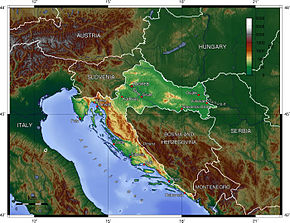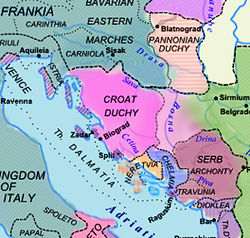Difference between revisions of "Directory talk:Croatia"
m (→The Our People) |
|||
| Line 28: | Line 28: | ||
==The Our People== | ==The Our People== | ||
The ''Naši People'' meaning 'Our People' or ''our own kind''. | The ''Naši People'' meaning 'Our People' or ''our own kind''. | ||
| + | |||
| + | *Naš jezik meaning ''our language''. | ||
| + | |||
| + | |||
| + | |||
| + | Sir John Gardner Wilkinson mentions it in 1848: Naski <ref>[https://books.google.com.au/books?id=ONQBAAAAYAAJ&pg=PA33&dq=Sir+John+Gardner+Wilkinson+naski+signifying+%22ours%22&hl=en&sa=X&ved=0ahUKEwjs0eul8-HdAhUIc3AKHcw4DPcQ6AEIJzAA#v=onepage&q=Sir%20John%20Gardner%20Wilkinson%20naski%20signifying%20%22ours%22&f=false</ref> | ||
'''Chronology''' | '''Chronology''' | ||
Revision as of 04:39, 30 September 2018
Notes
- Byzantines-Eastern Roman Empire (i.e. Procopius-Byzantine scholar, Jordanes- 6th century Roman bureaucrat) c. 550 Σκλαβῖνοι- Sklabenoi
- Latin: Sclaveni
- Hrvat in medieval times was pronounced "Harvat or Hrovat". Harvat/Hrovati was translated to Latin: Chroatorum and then simplified to Croatorum.
- Discovered In 1853 Χορούαθ[ος], Χοροάθος, Χορόαθος- Horoúathos, Horoáthos, and Horóathos (originally 3rd century AD-Tanais Tablets)
- Branimir's inscription c. 880: Croatorum (Latin)
- Baska tablet c.1100 AD: HR'VAT'SKI
Modern Croatian: Hrvatska
Chakavian Slavs
Old Chakavian Slavic speakers (Croatian tribes) must have arrived in the mid 700s (8th Century AD) and made the Dalmatian hinterland there home, one group went west as far as Histri (modern: Istria) and the other eastward to Montenegro.
There are no contemporary written records of Chakavian-Slavic speakers (Slavic-Croatian tribes) invasion/migration/settlement or about the events as a whole within the area itself. It is quite possible that the area had a drop in population (due to wars i.e. Frankish-Avar wars) and the military presents of the Byzantine Empire (Eastern Roman Empire) and the Carolingian Empire was minimal or even non existent. This would have lead to an easy invasion the of the area (opportunity beckons). The Roman Latin-Illyrian population as well as Liburnians, Greeks and others would have to have endured the arrival of the Sclaveni (Slavs). The Roman population survived within the coastal cities, on the islands and in the inhospitable Dinaric Alps.
It is quiet possible that the success of the Chakavian-Slavic tribes set the precedent for the Kajkavian-Slavic speakers and Shtokavian-Slavic speakers to follow suit. There is a very strong probability that the eastern Chakavian-Slavic tribes and Shtokavian-Slavic speakers started to mix, with that the Shtokavian-Slavic language becoming the Lingua Franca within the eastern part of Old Roman Dalmatia (thus begins Shtokavian-Slavic language move westward).
The first written records of Slavic-Croatians started in the late 8th (as Slavs first) and early 9th century.
I believe one of the reasons was that the Croatian tribes started to become western Europeanised (this amongst many others things includes written records). Within Dalmatian Ducatus of the Carolingian Empire (812) certain Croatian leaders became the political elite and took political leadership. In order to maintain this they became Christians thus connecting with Rome (via Carolingian Empire, the Dalmatian Roman City States i.e Spalatum, modern Split and the Republic of Venice). Then creating military alliances and trade with neighbors, etc, with this after a further period of time the mainland was mostly Slavicized. In terms of language Croatian Slavic Chakavian became Lingua Franca of the inland area and started to replace Latin Dalmatian (Romance). It has be written that within the Court of Duke Trpimir (dux Trepimerus/Trepime) two languages where spoken, one Slavic based and the other Latin based.
With this all happening the Carolingian Empire (as well as others) thought it to be good idea to work with as much as possible with the new arrivals Sclaveni-Croatorum for the there own invested interests.
The first of these was duke, Borna.
The Our People
The Naši People meaning 'Our People' or our own kind.
- Naš jezik meaning our language.
Sir John Gardner Wilkinson mentions it in 1848: Naski [1]
Chronology
- Prehistoric Croatia
- Illyrians tribes
- Roman Empire
- Ostrogoth Kingdom
- Carolingian Empire
- Kingdom of Croatia (925–1102)
With time one of the Slavic tribes within Dalmatian Ducatus of the Carolingian Empire became the political elite and the leaders (dux) of the province. It goes independent ......
Historic Croatia
- Kingdom of Croatia (925–1102)
then became part of ..... Kingdom of Hungary or Regnum Hungariae Some time after it lost its independents, the state Kingdom of Croatia (Regnum Chroatorum) in 1102, the political power within the Provence was transferred from Northern Dalmatia (no permanent seat. Nin, Klis, Bijaci and Knin) to the city of Zagreb, further inland (Zagreb was a Roman town of Andautonia). Zagreb today is the capital of modern Croatia.
Note: Harvat/Hrovati had there own province, the diplomatic name of the kingdom was "Kingdom of Croatia and Dalmatia" (Latin: Regnum Croatiae et Dalmatiae). Common Croatian language form of the name was Hrvatska Zemlja (Croatian country or 'Croatian land').
- Habsburg Monarchy - Austro Hungarian Empire
(Republic of Venice & Ottoman-Turkish Croatia)
- Yugoslavia
- Republic of Croatia
Habsburg Monarchy - Austro Hungarian Empire
Croatian territory under Habsburg rule was reduced to about 20,000 km².
Under Habsburg Monarchy
- we have Kingdom of Croatia
- then expanded Kingdom of Croatia-Slavonia
Yugoslavia
- During the history of Yugoslavia we have the Banovina of Croatia & Socialist Republic of Croatia.
These provinces incorporated Austro Hungarian Empire's old Kingdom of Dalmatia which included Republic of Ragusa's (Dubrovnik) old territory.
This means further territorial expansion to the current Croatia.
.

